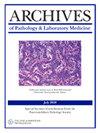Estrogen Receptor, Progesterone Receptor, and Human Epidermal Growth Factor Receptor 2 Expression Rates in Invasive Breast Carcinoma: A Study of 21 Institutions.
IF 3.7
3区 医学
Q2 MEDICAL LABORATORY TECHNOLOGY
引用次数: 0
Abstract
CONTEXT.— Laboratories performing predictive marker testing for breast carcinoma are encouraged to compare patient results to published benchmarks. OBJECTIVE.— To collect expression rates for estrogen receptor (ER), progesterone receptor (PgR), and human epidermal growth factor receptor 2 (HER2) in invasive breast carcinoma from multiple laboratories. DESIGN.— Participants submitted data from up to 50 primary cases during the study period. Participants reported ER, PgR, and HER2 results in addition to demographic and histologic information. Participants also provided annual institution-level expression rates. RESULTS.— A total of 21 institutions submitted data for 687 cases. Aggregate positivity rates for ER and PgR were 85.6% and 75.1%, respectively. Receptor positivity rates were higher in well-differentiated (grade 1) tumors (ER, 97.4%; PgR, 88.0%) compared with moderately differentiated (grade 2) tumors (ER, 92.4%; PgR, 84.0%) and poorly differentiated (grade 3) tumors (ER, 61.8%; PgR, 48.0%). Expression rates were higher in postmenopausal women (ER, 87.2%) than premenopausal women (ER, 79.6%) and higher in lobular carcinomas (ER, 98.7%; PgR, 85.3%) than ductal carcinomas (ER, 84.1%; PgR, 74.5%). The aggregate HER2 positivity (score 3+) rate was 9.0%. The aggregate HER2 equivocal (score 2+) rate was 14.5%. Of 81 equivocal (score 2+) cases, 70 (86.4%) were nonamplified. CONCLUSIONS.— The data from this study provide multi-institutional benchmark data to assist laboratories performing periodic comparisons as part of a quality management program. Overall expression rates were generally similar to those of other published reports, with the exception of the ER-negative and HER2-positive rates, both of which were somewhat lower.浸润性乳腺癌中雌激素受体、孕激素受体和人表皮生长因子受体 2 的表达率:21 家机构的研究。
背景:鼓励对乳腺癌进行预测性标记物检测的实验室将患者的检测结果与已公布的基准进行比较。目的:收集多个实验室的雌激素受体(ER)、孕激素受体(PgR)和人表皮生长因子受体 2(HER2)在浸润性乳腺癌中的表达率。除人口统计学和组织学信息外,参与者还报告了ER、PgR和HER2结果。结果:共有 21 家机构提交了 687 个病例的数据。ER和PgR的总阳性率分别为85.6%和75.1%。与中度分化(2级)肿瘤(ER,92.4%;PgR,84.0%)和分化不良(3级)肿瘤(ER,61.8%;PgR,48.0%)相比,分化良好(1级)肿瘤的受体阳性率更高(ER,97.4%;PgR,88.0%)。绝经后妇女的表达率(ER,87.2%)高于绝经前妇女(ER,79.6%),小叶癌(ER,98.7%;PgR,85.3%)高于导管癌(ER,84.1%;PgR,74.5%)。HER2阳性(3分以上)总比率为9.0%。HER2等位(评分2+)总比率为14.5%。结论:本研究的数据提供了多机构基准数据,有助于实验室进行定期比较,作为质量管理计划的一部分。除ER阴性和HER2阳性率略低外,总体表达率与其他已发表的报告基本相似。
本文章由计算机程序翻译,如有差异,请以英文原文为准。
求助全文
约1分钟内获得全文
求助全文
来源期刊
CiteScore
9.20
自引率
2.20%
发文量
369
审稿时长
3-8 weeks
期刊介绍:
Welcome to the website of the Archives of Pathology & Laboratory Medicine (APLM). This monthly, peer-reviewed journal of the College of American Pathologists offers global reach and highest measured readership among pathology journals.
Published since 1926, ARCHIVES was voted in 2009 the only pathology journal among the top 100 most influential journals of the past 100 years by the BioMedical and Life Sciences Division of the Special Libraries Association. Online access to the full-text and PDF files of APLM articles is free.

 求助内容:
求助内容: 应助结果提醒方式:
应助结果提醒方式:


